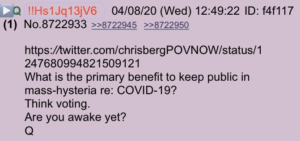
More Info
WILKES-BARRE, PA - AUGUST 2, 2018: A woman holds a "We Are Q" sign while in line to attend the "Make America Great Again" rally held at the Mohegan Sun Arena. "Q" stands for QAnon, a conspiracy group.
Brandon Stivers / Shutterstock
Classroom connection: QAnon conspiracy theory paved way for other hoaxes
Conspiracy theories about the COVID-19 pandemic can be described in a variety of ways — alarming, outlandish, dangerous — but they shouldn’t be surprising. Even the Plandemic “documentary” that suddenly swept its way across social media earlier this month did so on a path paved with fragments of pandemic conspiracy theories that were already in circulation.
But as a report by Adrienne LaFrance in the June issue of The Atlantic points out, if one theory has established conspiratorial thinking as an “acceptable” option in the modern marketplace of ideas, it’s QAnon.
Born in the aftermath of the Pizzagate debacle with two cryptic, anonymous posts published to the controversial message board 4chan in October 2017, QAnon has grown into a large and nebulous belief system. Its “leader,” known only as Q, is “a purportedly high-ranking government official.” At its heart is the baseless notion that President Donald Trump is secretly working to bring about a “Great Awakening” to expose an elite cabal of child sex abusers — including prominent political figures in Washington — that has been concealed by intelligence agencies, or “the deep state.”
QAnon conspiracy theory aims to simplify complex issue
In many ways, QAnon is a quintessential conspiracy theory: It offers its adherents simple explanations in place of complexity, a coherent entity on which to place blame for the transgressions of modern life, and a sense of control and populist purpose. But in other ways, it seems to have tapped into deeper veins of moral gratification: an apocalyptic vision of a renewed America that resonates deeply with evangelical Christian beliefs about the End Times. (Indeed, at least one church has been founded on QAnon belief principles.)
Whether they see QAnon as prophecy, as self-described “research” or as an “open source intelligence operation,” its followers have grown so numerous, and pushed its rhetoric so persistently on so many fronts online, that its most anodyne permutations — vague references to a coming reckoning for immoral Washington elites — are disturbingly present in mainstream discourse. They appear as Q icons and slogans at political rallies and are popularized by an increasing number of social media influencers and public officials.
 As it has grown, QAnon has expanded to absorb other conspiracy theories, explain away its own inconsistencies and incorporate new developments, such as the COVID-19 pandemic. So-called wellness influencers are spreading QAnon talking points alongside posts that tout unfounded “cures” or praise “holistic living.” And an April 8 “Q drop” — a post, said to be by Q, on an internet message board — had the cryptic message shown at left.
As it has grown, QAnon has expanded to absorb other conspiracy theories, explain away its own inconsistencies and incorporate new developments, such as the COVID-19 pandemic. So-called wellness influencers are spreading QAnon talking points alongside posts that tout unfounded “cures” or praise “holistic living.” And an April 8 “Q drop” — a post, said to be by Q, on an internet message board — had the cryptic message shown at left.
Related
- “’Immune to Evidence’: How Dangerous Coronavirus Conspiracies Spread” (Marshall Allen, ProPublica).
- “I was a conspiracy theorist, too” (Dannagal G. Young, Vox).
Discuss: What are the characteristics of conspiratorial thinking? How can entirely baseless conspiracy theories “feel” so right to some people? What role does evidence play in conspiracy theories? Why do you think conspiracy theories tend to arise during periods of great social and economic change? How do fear and anger contribute to the belief in conspiracy theories?